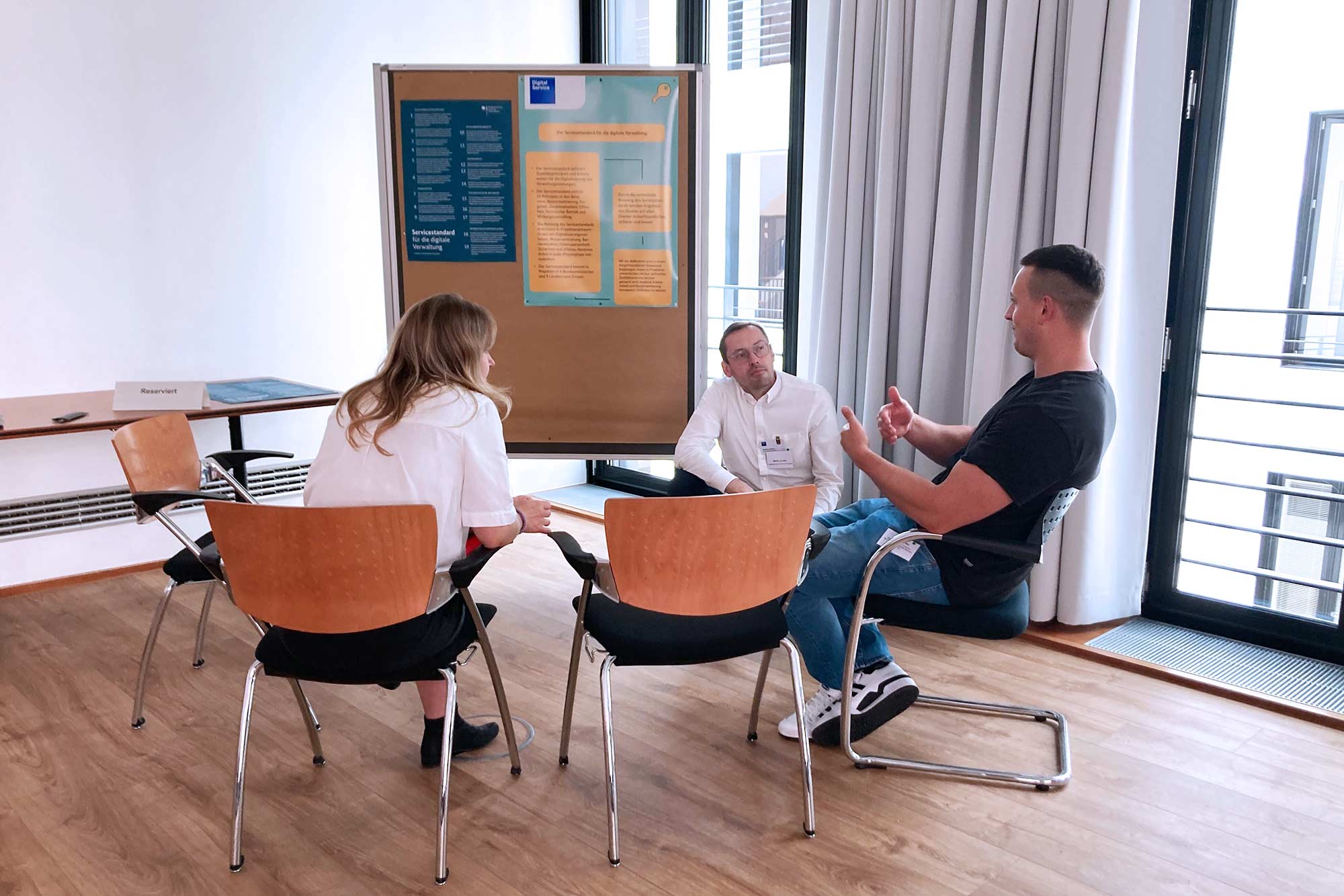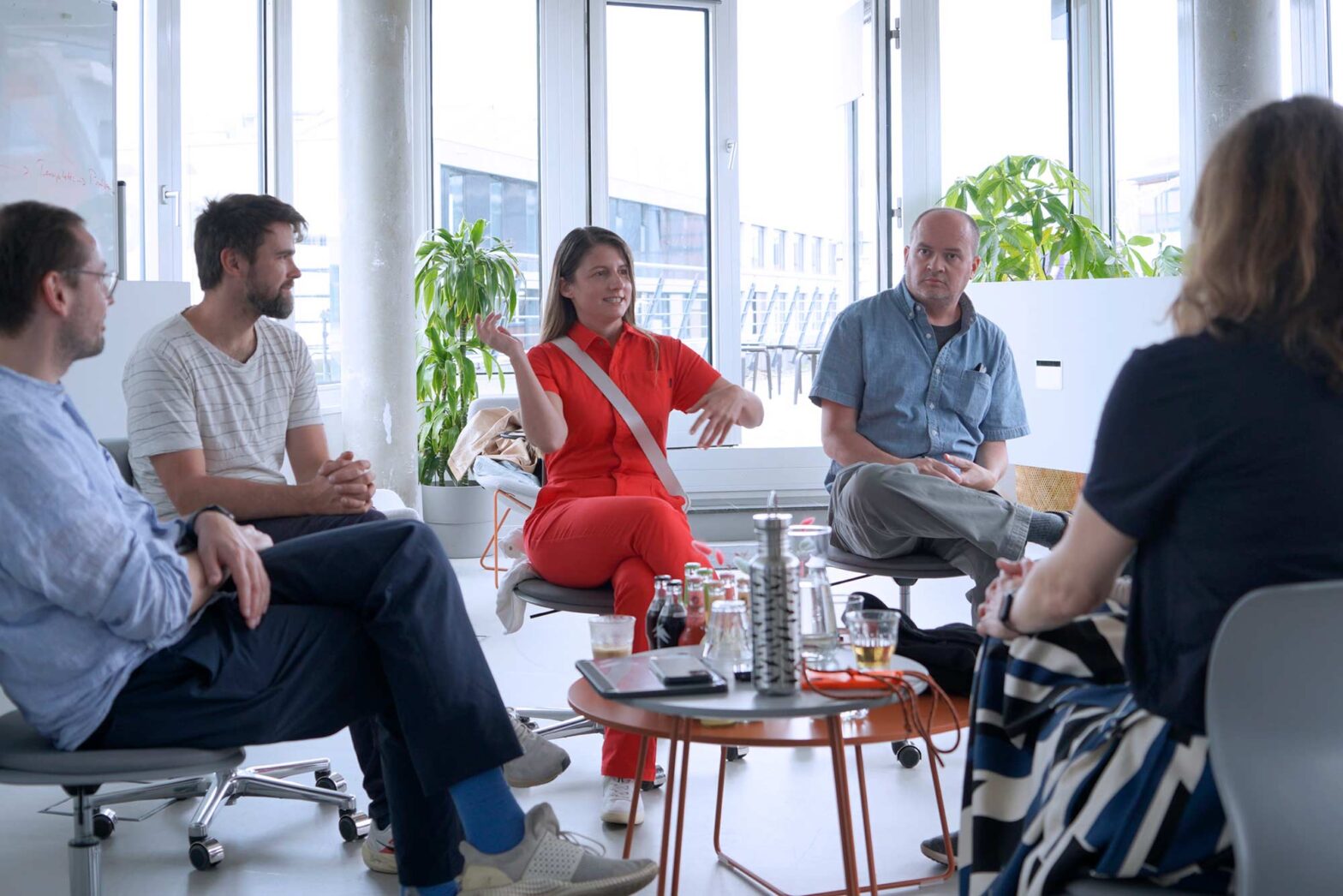This week felt as equally dense as the last one. While the Creative Bureaucracy Festival was over, some people were still in town. So, we made the best use of that fact.
Tamara Srzentić, Montenegro’s former Minister of Public Administration, Digital Society and Media, and Mikey Dickerson, the first administrator of the United States Digital Service, were still in Berlin until Monday evening and felt like they wanted to stop by. While our Executive Leadership team was out, it fell to me to quickly set up a lunch exchange format. We used a small, round table for six people: three guests, including Tamara’s partner, and three heads of discipline—Christian, Clara, and myself. An additional outer circle is formed of silent listeners, and anyone from the organisation who is interested can join that.
Despite the short notice, we got a crowd together virtually and in the room to follow the conversation. And despite Tamara and Mikey’s tight schedule, they stayed longer than had intended. In 90 minutes, we discussed how to utilise a crisis, accept more modest definitions of success, and look for the best levers for change. Mikey delivered an excellent input last week on ‘How to not let a good crisis go to waste’. There, he mentioned indicators for an emerging crisis and how to make practical use of it. In our conversation, we built on it.
Tamara dropped one of the most memorable sentences: “Citizens experience government through delivery of services.” This sentence links to a sentence in Kate Tarling’s book on service organisations I had read before, in which Kate writes: “The organisation is the service.” This notion still seems far from government decision-makers and senior policy-makers.
Tamara also emphasised how much she is interested in building a Rebel Alliance: “an open civic org/network that connects leaders dispersed all around the world with governments, nonprofits and civil society orgs in their home countries and beyond”, as she said in a recent interview.
There are various loose strands from the conversation, so I’m looking forward to meeting them again and also connecting with them for another remote exchange.
Bringing the designers and user researchers together
“Come because of the work, stay because of the people”, says a GDS poster my friend and former colleague Stephen McCarthy designed for the GDS design team. While the work is significant, it’s all about the people, their engagement and their lived values that make working at Digital Service so special.
On Thursday, our design and user research team had its summer offsite. It was the first time several colleagues met. 23 of us got together on a terrific upper floor at Impact Hub Berlin. Since our winter onsite, our discipline has grown by 40%. 8 new colleagues joined us since the beginning of 2024. By the end of summer, we will be 31 people and possibly 35 by autumn. So, we needed to take a day to zoom in and out, to meet and get to know each other better.

We started by recapping the past months and our work and achievements. We reflected on the fact that designing public services isn’t a sprint but a baton relay ultramarathon and the importance of resilience in that. Lena warmed us up by letting us find commonalities and craft name tags for one another. Our brilliant people partner, Magdalena, joined Charlotte and Sonja for an actionable positive psychology session on strengths and skills with an instant buddying format. Then, together, we ate 5 metres of pizza. Literally. After lunch, Dirk performed a banana shake dance with us to overcome the lunch slump. Going deeper, Marlene organised 90-minute barcamp-y sessions that people used to discuss topics like user research method libraries, handy AI tools, and improved narratives for user-centred design. Everyone put their energy and dedication into co-creating the day out.

“Having only joined a few weeks ago, I feel like I’m in a safe space where I can bring my true, full self”, a new team member said in our closing circle. “DigitalService is just a different place – without the usual egos”, another person voiced.
I’m massively proud of the team we’ve built over the last few years. This is my biggest design project so far, and we might have built the strongest design and user research team in the German public sector, which is a crucial foundation for building excellent public services.
7 years into Head of Design roles, leading this growing team is the greatest people responsibility I have had yet. I deeply respect the task and am careful to grow the team because human connections are essential. Working closely with our people team we have put an emphasis on supporting structures, frameworks, and processes to help us scale. Nothing is perfect, but compared to all large and small organisations I’ve ever worked for, it’s the best place I’ve seen. And together, we’ll only make it better going forward.
Talking about our work and the Service Standard once more
On Tuesday, Caro and I were invited to an event on the citizen-friendly welfare state at the Federal Ministry of Labour and Social Affairs. Together with about a dozen other actors, we hosted a corner in a world café setup and welcomed different public sector guests. We had about five minutes to introduce the Service Standard and its application in the context of justice services. Some 40 to 50 people stopped by through 3 cycles. Afterwards, we had a few extra minutes with interested people who were curious to hear more about the Service Standard.

On Wednesday morning, I went to the GovTech Campus. A group of tech entrepreneurs from my hometown, part of the association Magdeburg Digital, received an invitation from the state’s Chief Digital Officer, Tobias Krüger. In our roles as digital councillors for the state of Sachsen-Anhalt, he asked Ann Cathrin and me to talk about our work at Digital Service and NExT, respectively. So, I did and used a new deck I had not tried before.
We had a good exchange afterwards, in which I had to reassure a tech entrepreneur that we don’t take any business they are doing with the public sector but instead raise the bar and open doors for new approaches.We had a good exchange afterwards, in which I had to reassure a tech entrepreneur that we don’t take any business they are doing with the public sector but instead raise the bar and open doors for new approaches.
Taking fun seriously in annual pub quiz
The true quiz master, Chris, was absent, so I had to do it myself. Luckily, Sabrina jumped in with about 24 hours’ notice, and we ran the annual summer pub quiz together.
A core part of the Digital Service summer party since last year, we created 3 questions with 10 each. The categories were current affairs, general knowledge and public sector.
We had 11 groups, some with up to 9 players. The winning team got 23 points, and the low-performing one got 13. My favourite section is public sector knowledge. I asked about the ratio of costs and savings of De-Mail, the secure government email (6.5 € million spent; 3500 € saved in stamps); I asked when compulsory ID was introduced in Germany (1938); I wanted to know what point 15 of the Service Standard covers (reliability and IT security) and who was named Chief Information Officer, of the year 2024 by eGovernment magazine last week (Martina Klement). I also included a question from our German How many people tool.

People had good fun but also thought some questions were too difficult. We skipped the music section entirely. Chris needs to return next summer for the 2025 edition. The reward for the winning team is a custom sticker. I want our new communications designer, Bianca, to look at it.
What’s next
I need to finish my article for Touchpoint journal. I’m getting there, but it’s not finished, and I missed the deadline.
We’ll have an international call on Service Standards on Monday. I will speak at 2 events on Wednesday and Thursday.

